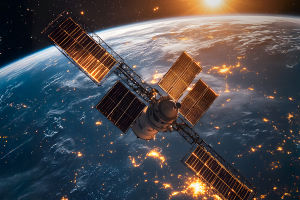Hey Lykkers!
Imagine staring up at the night sky, knowing that humans have actually left our planet and ventured into the vast unknown. Sounds unreal, right?
But behind every launch is a mountain of science and some mind-bending physics. Let’s unravel what it really takes to break free from Earth’s gravity and explore the final frontier.
Getting Off the Ground: The Gravity Challenge
The first and biggest hurdle in space travel is escaping Earth's gravity. Gravity is a force pulling everything toward the center of our planet — including rockets! To leave Earth, a spacecraft must reach what’s called escape velocity, which is about 11.2 kilometers per second (that’s roughly 25,000 miles per hour).
This speed is needed to overcome Earth's gravitational pull without falling back.
Why so fast? Imagine throwing a ball — the harder and faster you throw it, the farther it goes before gravity pulls it down. For a rocket, reaching escape velocity means it can break free and head into orbit or beyond. But getting to that speed requires massive energy — that’s why rockets are so huge and need tons of fuel.
Fuel and the Rocket Equation
Speaking of fuel, carrying enough to reach escape velocity is a huge engineering puzzle. This is where Tsiolkovsky’s Rocket Equation comes into play. It basically tells engineers how much fuel a rocket needs to carry relative to its payload (the stuff it’s bringing into space, like astronauts or satellites).
The tricky part? The more fuel you carry, the heavier the rocket, which means you need even more fuel to push that weight. It’s a classic catch-22! That’s why rockets are built in stages — they burn fuel and drop empty tanks along the way to shed weight and keep accelerating efficiently.
The Vacuum of Space: No Air, No Problem?
Once you’re in space, the environment changes drastically. There’s no atmosphere, which means no air resistance but also no oxygen. For space travel, this means:
- Rockets don’t rely on pushing against air; instead, they expel exhaust gases backward to propel forward — that’s Newton’s Third Law in action: “For every action, there’s an equal and opposite reaction.”
- Without air, heat doesn’t dissipate like on Earth. Spacecraft need special materials and cooling systems to manage the extreme temperatures — from scorching sun to freezing shadow.
Microgravity: Living in Free Fall
In orbit, astronauts experience microgravity — often called zero gravity — because they’re essentially in free fall around Earth. This environment causes some interesting effects:
- Astronauts float inside the spacecraft, which messes with their muscles and bones since they’re not working against gravity. That’s why astronauts exercise a lot in space.
- Fluids in the body redistribute, causing “puffy face” and other changes.
This microgravity isn’t a challenge for travel physics per se, but it’s a crucial factor in planning long missions.
Cosmic Radiation: The Invisible Danger
Beyond Earth’s atmosphere, astronauts face cosmic radiation — high-energy particles from the sun and distant stars. Our planet’s magnetic field and atmosphere protect us on Earth, but in space, this radiation can damage cells and increase cancer risk.
Shielding spacecraft from radiation without adding too much weight is an ongoing physics and engineering challenge. Researchers are exploring new materials and magnetic shielding concepts to keep crews safe on longer missions, like trips to Mars.
Speed, Distance, and Time: The Relativity Factor
Space is vast — even traveling at tens of thousands of miles per hour, getting to nearby planets takes months or years. The laws of physics, especially Einstein’s theory of relativity, tell us that as you approach the speed of light, time behaves differently. While current technology can’t reach anywhere near light speed, understanding these effects is crucial for future deep-space travel.
Wrapping It Up!
Space travel isn’t just about fancy rockets — it’s a complex dance with the laws of physics. From overcoming gravity and managing fuel to dealing with harsh environments and invisible radiation, every step requires mastering scientific challenges. But thanks to brilliant minds and relentless innovation, we’re inching closer to exploring more of the cosmos every day.
So next time you look up at the stars, remember the incredible physics powering every mission beyond our atmosphere.
5 Jaw-Dropping SPACE TRAVEL Secrets You Never Knew Existed!
Video By "Lions Mane "


